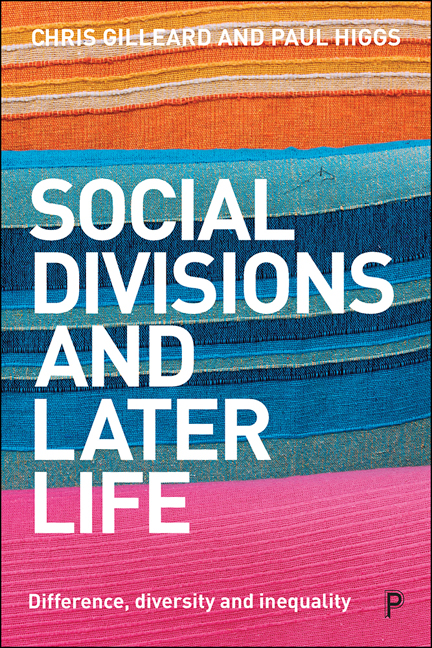Book contents
- Frontmatter
- Contents
- List of Figures and Tables
- Preface
- 1 Social Divisions and Social Differences
- 2 Social Class and Inequality in Later Life
- 3 Ageing and Gender
- 4 Ethnicity, Race and Migration in Later Life
- 5 Disability and Later Life
- 6 Identity and Intersectionality
- 7 Diversity, Difference and Division in Later Life
- References
- Index
5 - Disability and Later Life
Published online by Cambridge University Press: 25 February 2021
- Frontmatter
- Contents
- List of Figures and Tables
- Preface
- 1 Social Divisions and Social Differences
- 2 Social Class and Inequality in Later Life
- 3 Ageing and Gender
- 4 Ethnicity, Race and Migration in Later Life
- 5 Disability and Later Life
- 6 Identity and Intersectionality
- 7 Diversity, Difference and Division in Later Life
- References
- Index
Summary
Social divisions based upon ethnicity or race, gender or socio-economic position form relatively stable sources of identity across the life course. Other aspects of identity are less fixed, particularly those based on bodily appearance and physical functioning. While gender and race form relatively stable sources of embodied distinction, those categories associated with the corporeal markers of illness, impairment or infirmity decidedly do not. Though capable of serving as sources of identity and implicated in various forms of discrimination and inequality, disability and infirmity form rather more contingent sources of social division in part because of the temporal flux within which they emerge. There is a distinction, for example, between the predictable status of becoming aged and the less predictable status of becoming disabled, ill or infirm. Most people see bodily change as constituting the ‘authentic’ basis of age and ageing; reminders of the inevitable temporality that is attached to identity, location and status. Those changes that are evidenced by the ageing body, which do not reflect illness or impairment, best signify the universality attributed to growing old. However, the ageing body is also a site and signifier of illness and infirmity, neither of which convey the same message of inevitability, predictability or universality. The statuses of illness, impairment and infirmity embody and reflect the operation of chance and misfortune in a way that ageing does not; and hence they imply an inequality or unfairness that age lacks. And though culture and society may help or hinder the processes of illness and of infirmity, society per se is not considered their originating cause (Mendes de Leon and Rajan, 2014). Although the social provides the context within which people-as-bodies are framed and understood, the body's corporeality serves as the critical reference point for the signs of both ageing and infirmity. Corporeality acts as a common base. Its materiality as age, however, cannot be so easily subcontracted out to the operations of the economy, culture or society: Though in some sense a social division, it is not imbued with the same intimations of unfairness and misfortune.
Bodies, however thoroughly represented by their corporeality, cannot be easily separated from social processes. Ageing, just like impairment and infirmity, occurs within bodies but also within societies; but unlike impairment and infirmity, age does not reflect already existing social divisions nor does it construct new ones.
- Type
- Chapter
- Information
- Social Divisions and Later LifeDifference, Diversity and Inequality, pp. 95 - 122Publisher: Bristol University PressPrint publication year: 2020



